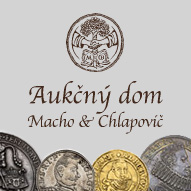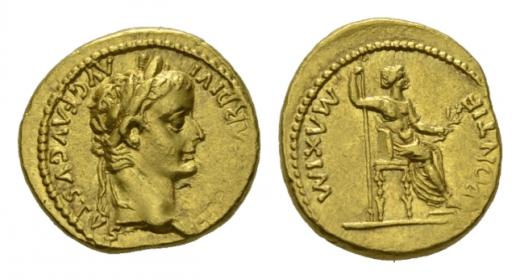Tiberius
Příjem limitů končí:
Sobota 22.2.2014, 12:00:00.
Zbývající čas: Příjem limitů byl ukončen
Tiberius, 14-37 Aureus Lugdunum circa 14-37, AV 19.5mm., 7.84g. TI CAESAR DIVI – AVG F AVGVSTVS Laureate head r. Rev. PONTIF MAXIM Pax-Livia figure seated r. on chair with ornamented legs, holding long vertical sceptre and branch. C 15. BMC 46. RIC 27. CBN 13. Calicó 305a.A magnificent portrait of excellent style struck on a full flan. Good extremely fineThe aurei and denarii of Tiberius with the 'Pax seated' reverse are among the most familiar coins of antiquity, at the very least because the denarius is usually described as the 'Tribute Penny' of the Bible. The type was one of three used by Augustus in the final year of his life, 13-14, and was adopted by Tiberius, who struck it as the principal type of his reign. The figure on the reverse - a seated female holding a sceptre and branch - certainly must be Pax if it is meant to represent a deitiy or personification, as her attributes meet that requirement perfectly. More importantly: does 'Pax' represent Livia? For the answer we might look at later coinage that might have been designed with an eye to the past. Galba provides ideal evidence, as he honoured his old friend and patroness Livia (then diva) to help legitimise his own principate. The fact that Galba struck aurei and denarii with the deified Livia standing and the accompanying inscription DIVA AVGVSTA is enough to establish the connection. However, to learn more about the seated 'Pax' type of Augustus and Tiberius, we must look to Galba's sestertii. There we find a type with an identical seated 'Pax' with the inscription AVGVSTA in the exergue. Kraay (Aes Coinage of Galba, NNM 133, p. 58) rightly showed no hesitation in identifying the seated figure as Livia - not even as Pax-Livia. The combination of Galba's explicitly labeled aurei and denarii, and his remarkable sestertius, must lead us to conclude that the 'Pax' on the coins of Augustus and Tiberius represented Livia, as these coins still would have been current - even common - during Galba's reign, and he no doubt chose to depict Livia in the 'seated Pax' format because it would have been instantly understood by the public.




